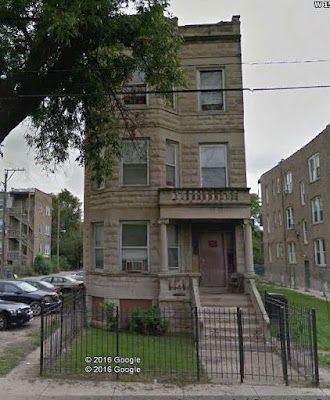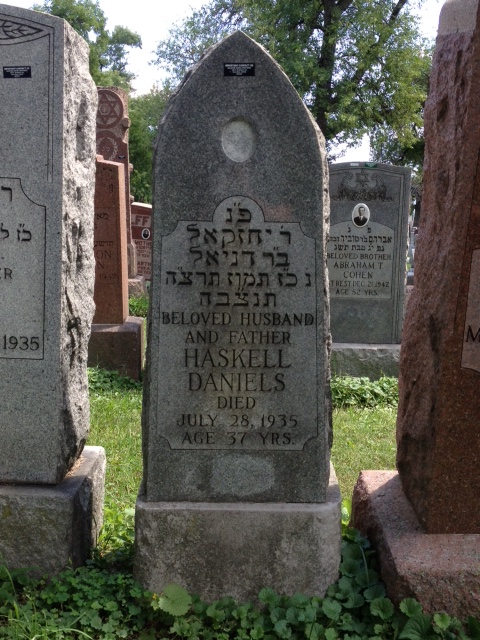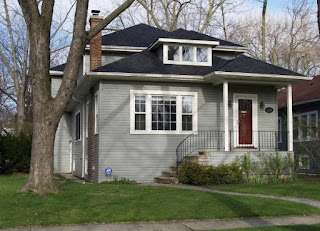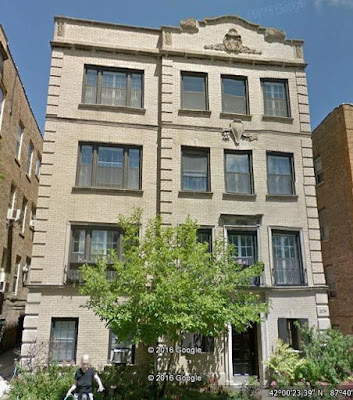Recently I received the following email:
First, thank you very much for posting Sam Daniel z"l headstone at Waldheim. You even had his picture - how in the world did you obtain that? I found his tombstone last year, but it did not have the picture.
I do have an interesting question, but allow me to give you some background first: My maternal grandfather, Haskell Daniels z"l, is also buried at Waldheim. He was shot and murdered by burglars at the Liggett Drug Store at the Northwestern Train Depot in Chicago on July 28, 1935.
Wow! We know murders happen all the time in Chicago but it very sobering to find someone who has a personal connection to someone who was murdered.
Back in April of 2012 I told the story of waiter/actor Harry Iglowitz who was gunned down in cold blood in front of the Parody Cafe in downtown Chicago on December 5, 1927:
http://undereverytombstone.blogspot.com/2012/04/absolute-terror-reigned-harry-smith-aka.html
In telling Harry's story I pointed out that he was in the wrong place at the wrong time. We can say the same about Haskell Daniels. Before we look at the circumstances surrounding his murder, let's see what other information we can "dig up" about him.
Y'chezkayal bar Danial was born May 15, 1899 in Urmia, Azarbayjan-e Bakhtari, Iran. Family legend says he was Assyrian/Armenian and Persian. Like many immigrants, the man we now call Haskell Daniels changed his "English" name several times during his lifetime. The family has a business card of his that says "Haskel Daneal"; his marriage certificate from 1920 says "Haskel Danial"; when his first child was born in 1921, it was "Haskell Daniel" and by the time his youngest daughter was born in 1928, his name was "Haskell Daniels." In this story about him, we'll call him "Haskell Daniels."
Haskell Daniels came to the US in 1913 and joined his brother Sam Daniel who was already living in Chicago. Unfortunately Sam Daniel died on May 15, 1914.
We don't know too much about the parentage of Haskell or Sam. In one death record, Sam's father is listed as "Ezuler" Daniel, and in another it is listed as "Ez?l?" Daniel. Nothing is known of their mother.
On a happier note, Haskell Daniel married Sophie, nee Glick (1900-1988) on August 22, 1920 in Chicago. Sophie Glick was born Bathshewa Shtiglick in Ruzin, in the Zhytomyr region of Ukraine. In 1891 the population of Zhytomyr province was 69,785 of which 24,062 were Jews. In later years Sophie related that her family left Ukraine to escape the constant pogroms like the one that occurred May 7-8, 1905 in which 10 Jewish children were murdered.
We don't know too much about the parentage of Haskell or Sam. In one death record, Sam's father is listed as "Ezuler" Daniel, and in another it is listed as "Ez?l?" Daniel. Nothing is known of their mother.
On a happier note, Haskell Daniel married Sophie, nee Glick (1900-1988) on August 22, 1920 in Chicago. Sophie Glick was born Bathshewa Shtiglick in Ruzin, in the Zhytomyr region of Ukraine. In 1891 the population of Zhytomyr province was 69,785 of which 24,062 were Jews. In later years Sophie related that her family left Ukraine to escape the constant pogroms like the one that occurred May 7-8, 1905 in which 10 Jewish children were murdered.
Sophie's father was Rabbi Joel David Shtiglick (1875-1951). He was both a rabbi and a cantor. He, too, Americanized his last name to "Glick." Sophie's mother was Bronna Rivka "Rebecca" Glick (1872-1917). Sophie and her family came to the U.S. in 1911.
Haskell Daniels is not listed in the 1920 US Census, but the family has a business card that says:
Haskell Daniels is not listed in the 1920 US Census, but the family has a business card that says:
Haskell Daneal
Dealer in Madeira Cluny Laces, Lace Curtains, Table Linens, Bedspreads and Silk Underwear
Office: 1039 W. Roosevelt Road, Chicago, Illinois
Phone: Canal-0295
Residence 1403 W. Roosevelt Road
A new apartment building stands at 1403 W. Roosevelt Road today. 1039 W. Roosevelt Road is now a park.
Haskell and Sophie were blessed with three children: Daniel (1921-2003), Reva (b. 1923), and Sybil (b. 1928).
Haskell Daniels and his family did participate in the 1930 US Census. It showed them living in an apartment at 3123 W. 15th Street in Chicago:
 |
| 3123 W. 15th Street, Chicago |
They paid $43.00 per month rent for their apartment. 35-year-old Haskell reported his occupation as "Elevator (Operator) in a Depot." There was also 27-year-old Sophie, 9-year-old Daniel, 7- year-old Riva, and 2-year-old Ceba. Haskell reported his mother-tongue as "Hebrew," Sophie said hers was "Jewish." Also living with them was a "Lodger" - 45-year-old Mike Jacob who was from Persia and was a porter at the depot. Mike Jacob's mother-tongue was also "Hebrew." They were not naturalized citizens yet, but had filed papers to start the process.
That brings us up to that fateful day: July 28, 1935. Haskell Daniels was working as an elevator operator at the Northwestern Depot in Chicago.
What took place made the headlines of the Chicago Daily Tribune from July 29, 1935:
Robbers Raid Station; Routed in Gun Battle
An elevator operator was killed, a robber fatally shot, and a policeman seriously wounded late last night in a pistol battle that followed a holdup of Liggett's drug store in the Chicago and North Western station. The wounded robber was captured and died early today in the Bridewell hospital. His two companions escaped with the money, about $125, they had taken from the store.
All the shooting, in which two policemen and the trio of bandits took part, occurred in the broad lobby of the station and was witnessed by dozens of passengers passing through to board late trains. These witnesses first paused in astonishment and then scurried hastily for cover as the bullets spattered against the walls or crashed through the windows of the stores around the lobby.
Policeman Shot in Head.
Daniel Haskell (sic), 30 years old, was the man slain on the spot. The wounded policeman, who was struck in the neck and the right side of the jaw, is James H. Frawley, 39 years old, 3851 North Kedvale avenue, of the homicide squad. The slain bandit was identified as Samuel Manno, 25 years old, 825 South Marshfield avenue.
He was shot down by Policeman Franklin Smith, 38 years old, 4259 North Hamlin avenue, of the bureau of identification, after he and his companions had wounded Frawley and had separated in their effort to escape. Possessor of a long police record, Manno remained tough in the hospital. He declined the rites for the dying and refused to tell who his companions were.
Shot Warns Policeman.
Policemen Frawley and Smith, released only a short time before from their duties at the detective bureau, were in the lobby awaiting a suburban train when they heard a shot in the drug store, which is near the south west corner of the lobby. This shot, supposedly was intended for Haskell, who had just stepped from an elevator beside the only one of the three store entrances that was open.
Its significance was recognized by the policemen, who were spending their waiting time playing a marble machine near the staircase at the north side of the lobby that leads to the train shed.
"It's a stickup," said Frawley to Smith. "You take the Clinton street entrance. I'll keep them from getting out on the Madison street side."
Elevator Operator Slain.
As Smith hurried over to take his place Frawley moved toward the drug store door. At this moment the robbers pushed through the store door. Haskell, who had stood rooted with astonishment and fear when he was fired on first, was directly in their path still. Two bullets were poured into his body and he fell.
Frawley promptly began shooting and the three bandits turned their guns against him. One bullet struck him and the others plunked into a post behind him. As he dropped, the gunmen ran in different directions. Manno, pistol in hand, darted toward the Clinton street entrance. He fired at Smith, but the policeman was the better shot and his bullets struck the bandit twice in the abdomen. Manno plunged forward on his face directly in the entrance.
Two Bandits Escape.
Another of the bandits ran past the stricken Frawley and up the stairs to the train shed. On the way he threatened Otto Bottger, a railroad telegrapher from Crystal Falls, Mich., with his gun. Then he ran out on the platform and disappeared among the cars standing on the tracks.
What became of the third bandit was not learned. It was believed by the police that he concealed his pistol and mingled in the crowd of several hundred that quickly gathered in the lobby, thus escaping detection. One suspect was arrested by Sergt. John Gapinaki of the detective bureau, but there was no certainty he belonged to the gang.
Employees of Liggett's store told the police what had happened during the robbery. Peter J. Zaremba, 3236 Elston avenue, manager, said the trio had entered in the guise of customers shortly before closing time. As the others lounged up to a counter, one man went to Louis Herzer, 65 years old, 2143 Humboldt boulevard, a floor-man, who was putting money in the safe. and, without warning, crashed a pistol butt against his head.
Robber Flees with Bills.
Herzer dropped with a stifled cry. The robber was about to go through the drawers of the safe, which held about $3,000, when one of his companions saw Haskell outside and cried: "We're trapped." He then fired the shot that attracted the attention of the policemen.
The robber at the safe became alarmed. He was nearer to the door than the others and was first out. He, it was believed, was the one who killed Haskell and wounded Frawley, and was probably the man who threatened Bottger.
Policeman Frawley was taken to the Mother Cabrini hospital. Physicians, after examining his wounds, said he had a chance for recovery, but that a blood transfusion might be necessary. A decision on this point will be made this morning. Twenty-five policemen, among them Frawley's partner, Detective James Sullivan, volunteered to give their blood.
Frawley is married and the father of two small children. His wife and his mother, Mrs. Mary Frawley, 17 West Maple street, were at the bedside early today.
In the editions of July 30th, the Tribune still had Haskell Daniels' name backwards:
HUNT 3 BANDITS AFTER N.W. DEPOT HOLDUP KILLINGS
Wounded Policeman Is Given Chance to Live.
Police squads combed the west side yesterday and last night for three of a band of four gunmen who late Sunday night killed one man and seriously wounded a policeman in a robbery raid on the Liggett drug store in the Chicago and Northwestern railway station. The fourth bandit was fatally wounded during the revolver battle in the station lobby after the holdup.
Policeman James H. Frawley, 39 years old, 3851 North Kedvale avenue, of the homicide squad, who was shot in the right side of his jaw, was reported to have an excellent chance to recover at the Mother Cabrini hospital yesterday. At first his condition was considered critical, but a blood transfusion which physicians earlier considered vital for Frawley, was pronounced unnecessary.
Elevator Operator Slain.
Daniel Haskell, 38 years old, 1257 Washburne avenue, an elevator operator in the depot, was slain by the robbers when he inadvertently stepped into their paths of escape. Dozens of persons waiting for late suburban trains witnessed the gun battle between the robbers and Policemen Frawley and Franklyn Smith, 38 years old, 4259 North Hamlin avenue, of the bureau of identification.
Both policemen were in the station, awaiting the departure of trains, when they heard the robbers' first shot. They separated immediately to halt the gunmen's flight - at the Clinton street and Madison avenue entrances to the station. Frawley had started toward the Madison street entrance when he encountered the gunmen as they left the store and shot down Haskell.
Slain Bandit Has Record.
Sam Manno, 22 years old, 825 South Marshfield avenue, the slain bandit, had been arrested several times previously as a robber suspect, police department records showed. Three known companions of Manno who were arrested several months ago as robber suspects were being sought for questioning yesterday. They are Louis Filecetti, Joseph Gallichio, and James Micelli.
Vincent Farrindino, 29 years old, 1009 Cypress street, was taken into custody when the police received information that he had been a close friend of the slain bandit. He denied that he had been with Manno Sunday night, asserting that he had been at a lake beach with a young woman until 3 o'clock yesterday morning.
Manager Slugged at Safe.
Louis Herzer, 65 years old, 2143 Humboldt boulevard, manager of the drug store, was preparing to close the store for the night and was placing money in the safe when the four bandits sauntered in. One of the quartet had walked back of the counter and struck Herzer over the head with a pistol when one of the store employees sounded an alarm in the lobby of the station. This alarm, followed quickly by a shot as the frightened bandits fled, firing at Haskell, attracted the attention of the two policemen.
Policeman Frawley fired several shots at the scattering group before he fell wounded, and Policeman Smith, who had hurried to guard the Clinton street entrances of the building, shot down the fleeing Manno as the bandit fired twice at him.
It was first reported that the bandits had gotten $125 from the safe, but it later was found that in their fright and rush to escape they had obtained nothing.
An inquest into the deaths of Manno and Haskell will be held at the county morgue this morning.
By Wednesday, July 31st, the story hardly gets a mention but the Tribune finally got Haskell Daniels' name right:
SUSPECT ADMITS BEING LOOKOUT IN FATAL HOLDUP
Tony Spranze, 23 years old, 311 South Leavitt street, who was arrested at the scene of the robbery and shooting in Liggett's drug store in the North Western railroad depot Sunday night, confessed to the police yesterday that he acted as lookout for the robbers. One of his companions, Sam Manno, and an elevator operator, Haskell Daniels, were killed, and Policeman James H. Frawley was wounded in a pistol battle that followed the robbery. In previous reports of the case Daniels' name has been given as Daniel Haskell.
In his confession yesterday Spranze named Joe Mirrabella, alias Belmonti, and Joseph Gallichio as two of the robbers. The police are also seeking James Micelli, a companion of Manno, as a suspect.
Squads under Sergt. John Hanrahan raided an apartment at 1344 Elburn avenue in a hunt for the robbers and seized James Mirro, 24 years old; Paul Pelletier, 32 years old, and his two brothers, Rocco, 17, and John, 24. Two pistols were found in the apartment.
Vincent Ferrindino, who was being held by the police as a suspect, was pointed out by a witness at a showup yesterday at the detective bureau as resembling one of the robbers.
Here is Haskell's death certificate, filled out after the inquest:
Haskell Daniels was buried on June 30, 1935, at Jewish Waldheim Cemetery in Forest Park, at Gate #37 - Progressive Order of the West - Section 44N, Row 77, Lot 314, Grave 3:
I have written before in this blog about the "other victims" when someone is murdered - the deceased person's family and friends. The widow, Sophie Daniels could not be immediately located by the authorities - this was before the days when one's every move could be tracked. Young Daniel Daniels was the one who found out first about his father's murder. He was at camp somewhere in Chicago and it was broadcast on the radio. Someone brought Danny into the camp office and he heard the radio broadcast about his father. What a way to hear about your own father's death! Someone from the camp gave him a ride to Sophie's parents' house and that's where he told Reva. Because of the crimes of Sam Manno and company, Sophie Daniels was left to raise her three children alone - but the shock was too much and shortly after her husband's murder, Sophie Daniels suffered a nervous breakdown.
Sophie died in 1988, and Daniel Daniels died in 2003, but Haskell's two daughters, Reva and Sybil are still very much alive as I write this story 81 years to the day after Haskell was killed. I'm sure that there is not a day that goes by when they don't think about their father taken from them when they were just eleven and six.
Here's what Haskell's granddaughter had to say about this:
What makes the story of my grandfather's murder even more sad (if that were possible) is that he was murdered the day before my mother's birthday. He was murdered Sunday, July 28, 1935. My mother's birthday is July 29; it was her 7th birthday. Family lore has it that he was carrying my mother's birthday present under his arm at the time of the hold-up and subsequent murder. I also have a copy of the coroner's report; the date on that is July 30, 1935.
For many years my mother thought her father was murdered on her birthday. About 25 or 30 years ago, I took her to Waldheim and showed her the true date of death. You could see mixture of relief and sadness on her face. I told her that between the date on the tombstone and the date on the coroner's report, there was absolutely no way her father was killed (or for that matter, buried) on her birthday.
Haskell Daniels, who came to this country hoping for a better life, instead had his life ended by being in the wrong place at the wrong time. May he rest in peace.
Here is Haskell's death certificate, filled out after the inquest:
Haskell Daniels was buried on June 30, 1935, at Jewish Waldheim Cemetery in Forest Park, at Gate #37 - Progressive Order of the West - Section 44N, Row 77, Lot 314, Grave 3:
I have written before in this blog about the "other victims" when someone is murdered - the deceased person's family and friends. The widow, Sophie Daniels could not be immediately located by the authorities - this was before the days when one's every move could be tracked. Young Daniel Daniels was the one who found out first about his father's murder. He was at camp somewhere in Chicago and it was broadcast on the radio. Someone brought Danny into the camp office and he heard the radio broadcast about his father. What a way to hear about your own father's death! Someone from the camp gave him a ride to Sophie's parents' house and that's where he told Reva. Because of the crimes of Sam Manno and company, Sophie Daniels was left to raise her three children alone - but the shock was too much and shortly after her husband's murder, Sophie Daniels suffered a nervous breakdown.
Sophie died in 1988, and Daniel Daniels died in 2003, but Haskell's two daughters, Reva and Sybil are still very much alive as I write this story 81 years to the day after Haskell was killed. I'm sure that there is not a day that goes by when they don't think about their father taken from them when they were just eleven and six.
Here's what Haskell's granddaughter had to say about this:
What makes the story of my grandfather's murder even more sad (if that were possible) is that he was murdered the day before my mother's birthday. He was murdered Sunday, July 28, 1935. My mother's birthday is July 29; it was her 7th birthday. Family lore has it that he was carrying my mother's birthday present under his arm at the time of the hold-up and subsequent murder. I also have a copy of the coroner's report; the date on that is July 30, 1935.
For many years my mother thought her father was murdered on her birthday. About 25 or 30 years ago, I took her to Waldheim and showed her the true date of death. You could see mixture of relief and sadness on her face. I told her that between the date on the tombstone and the date on the coroner's report, there was absolutely no way her father was killed (or for that matter, buried) on her birthday.
Haskell Daniels, who came to this country hoping for a better life, instead had his life ended by being in the wrong place at the wrong time. May he rest in peace.
 |
| Haskell Daniels |












































